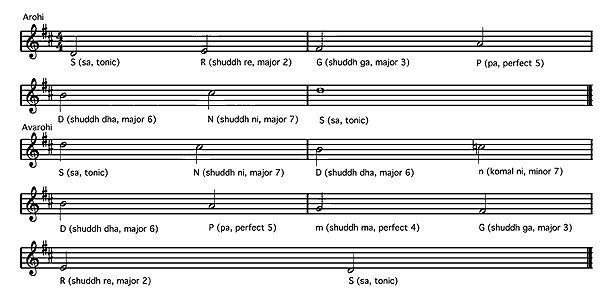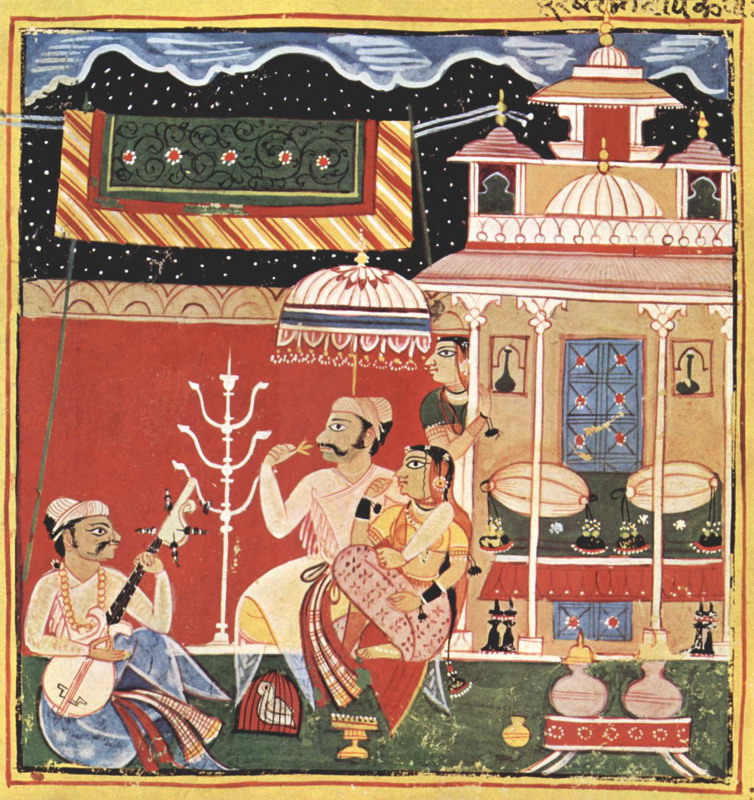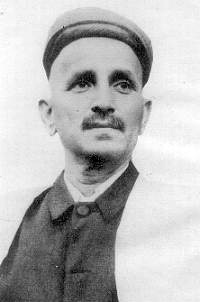Indian music uses three sections: melody, the main section of the songs (instruments include sitar, sarod and sarangi (Indian stringed instrument played with a bow, similar to a violin in both shape and timbre); rhythm, played on percussion such as dhol and tabla (twin drums); and drone, a pattern of repeated notes played on instruments such as the tambura and the surpeti (a small box, can be manual or electronic).

(Picture from http://www.ancient-future.com/images/arohiavarohi.gif.) An Indian raga, written in Western notation.
An Indian song will start with an alap (also splet alaap). This is a slow, instrumental section without any percussion. It is based upon the notes of a raga. Ragas are basically the concept of "scales" but the word itself (from the Sanskirt raga 'colour' or 'melody', related to the word for 'it is dyed') conveys so much more than a simple pattern of notes. Ragas are constructed out of five or more swara, which are quite simply just musical notes, played ascending and decending. They are: Sa, Re (also spelled Ri), Ga, Ma, Pa, Dha and Ni, shortened versions of their full Sanskrit names. In contradistinction to Western music, which has a limited selection of scales (such as the major and minor scales), there are hundreds of ragas. Which ragas is played depends on the time of the year or day and the feeling you want to achieve. Some feelings in Sanskrit include shanta (peace) hasya (happiness), bhaya (fear) and shingara (romance, love).
In order to play a raga you must not only remember which note to play, you must also remember than some swara take precendence over others. These are the vadi (king) and samvadi (vice-king or queen). The vadi is the most emphasised swara; the samvadi is a slightly less emphasised swara. Neutral swaras are known as anuvadi. Swaras which are quietened are known as durbal and ommited swaras are known as vivadi. However, in recent years this element of Indian music is becoming less important and may be eventually abandoned.
The swari can be divided into 22 shruti, said to be the smallest divisions audible. However, there has been scientific controversy both within and out of India regarding the exact number of shruti; the figure of 22 is based on the calculations of of Bharata, an ancient musicologist, and some have suggested that the number has changed since his time around the 3rd century BCE.

(Picture from http://upload.wikimedia.org/wikipedia/commons/c/c3/Sahibdin_%27Ragmala_Dipak-raga%27.jpg. A 17th century depiction of a raga performance.
Another element of Indian music is tal (from tal 'clap'), or rhythm, played on drums. Such patterns are used within Northern and Southern Indian music. They were first used within the Gandharva system of Indian music. In Southern or Carnatic music tals are sorted into different categories based on what jati (tala family) they belond to. In Hindustani or Northern Indian music, talas can be written down in a somewhat complicated notation system in which constists of pictoral representation of beats with marks to indicate which beats are especially significant, such as khali, a wave of the hands (the word means 'empty') ; tali, a clap of the hands, and sam, the start of the sequence. The system of notation is called swar lippi and is largely based around the work of Vishnu Bhatkande (1860-1936).

(Picture from http://upload.wikimedia.org/wikipedia/commons/9/92/Bhatkhande.jpg. Vishnu Bhatkande, who developed a system of notation for Hindustani classical music which remains used today at a time when Indian music was exclusively oral.
After the alap there may be a jor; this is a slightly faster intermediately-paced section of the song as a continuation of the alap and rag, It has a basic rhythm but no real cycle and is still sans percussion. The emotional function of the rag continues into the jor. Although the jor and especially its vocal vesion, the nomtom, have experienced a small drop in popularity, the jor remains a feature in almost all Indian song.
At the end of the jor the tal and gat begin. The gat is the only major section of the song which is not improvised but instead copied from written music. Two main types of gat exist, although the distinction is vague; masitkhani (the fundamental slow gat) and razakhani (fast gat). The gat acts as a sort of melody or chorus, although it is quite different. The gat is also known as a bandish from the word for 'binding together'. It is also the part of the song that provides the tune for singing.

(Picture from http://www.vedicbooks.net/natyasastra-bharata-muni-p-3676.html). The Natyashastra, the magnum opus of ancient musicologist and theatrologist Bharata who devised the system of shruti.
Finally near the end of a song there is a jhala, an improvised section with an extremely fast tempo and a tal. Sometimes the tal will overwhelm the melody at this point. It is almost always used at the end of a sitar or sarod performance. During the jhala the sitar player puts emphasis on the two chikaris (drone strings) to create a unique sound.
An example of an Indian musician playing a typical gat on sarod from 1937 can be seen here:
SOURCES USED;
Wikipedia
chakrakantha.com
http://www.slideshare.net/acaaguilar/elements-of-indian-music
http://indianraga.blogspot.co.uk/2009/09/appreciating-alap-jor-and-jhala.html
http://users.unimi.it/~gpiana/dm2/dm2talnr.htm
and others.
No comments:
Post a Comment